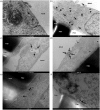The challenges of oral drug delivery via nanocarriers
- PMID: 30394120
- PMCID: PMC6225504
- DOI: 10.1080/10717544.2018.1501119
The challenges of oral drug delivery via nanocarriers
Abstract
The oral application of pharmaceuticals is unarguably the most convenient method of application. Especially for protein- or peptide-based drugs, however, the effectiveness is significantly reduced due to enzymatic digestion in the stomach as well as a poor bioavailability in the small intestine. For these difficult formulations, the encapsulation into nanocarriers would protect the sensitive drug and thus could considerably improve the efficiency of oral drug delivery. In the last years, many candidate biodegradable nanomaterials for such carrier systems have been published. However, before the cargo can be released, the nanocarrier needs to cross multiple barriers of the human body, including a layer of intestinal mucus and epithelial as well as endothelial cells. For overcoming these cellular barriers, transcytosis is favored over a paracellular transport for most nanomaterials as paracellular transport routes lack selectivity of transported molecules once opened up. The exact mechanisms behind the transcellular translocations are up to now still not completely understood. For the vast majority of nanocarriers, the rate of transcellular transport is not sufficient to realize their application in oral drug delivery. Especially trafficking into the endolysosomal pathway often marks a key problem. In this review, we focus on the molecular mechanisms of overcoming cellular barriers, especially transcytosis, and highlight difficulties of oral drug delivery via nanocarriers.
Keywords: Nanocarrier; barrier; biodegradable nanomaterial; drug delivery; exocytosis; transcytosis; transport.
Figures




References
-
- According to personal communication from abdata.de (2017)
-
- Antileo E, Garri C, Tapia V, et al. (2013). Endocytic pathway of exogenous iron-loaded ferritin in intestinal epithelial (Caco-2) cells. Am J Physiol Gastrointest Liver Physiol 304:G655–61. - PubMed
-
- Bannunah AM, Vllasaliu D, Lord J, Stolnik S (2014). Mechanisms of nanoparticle internalization and transport across an intestinal epithelial cell model: effect of size and surface charge. Mol Pharmaceutics 11:4363–73. - PubMed
-
- Bazzoni G, Dejana E (2004). Endothelial cell-to-cell junctions: molecular organization and role in vascular homeostasis. Physiol Rev 84:869–901. - PubMed
Publication types
MeSH terms
Substances
LinkOut - more resources
Full Text Sources
